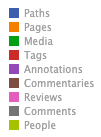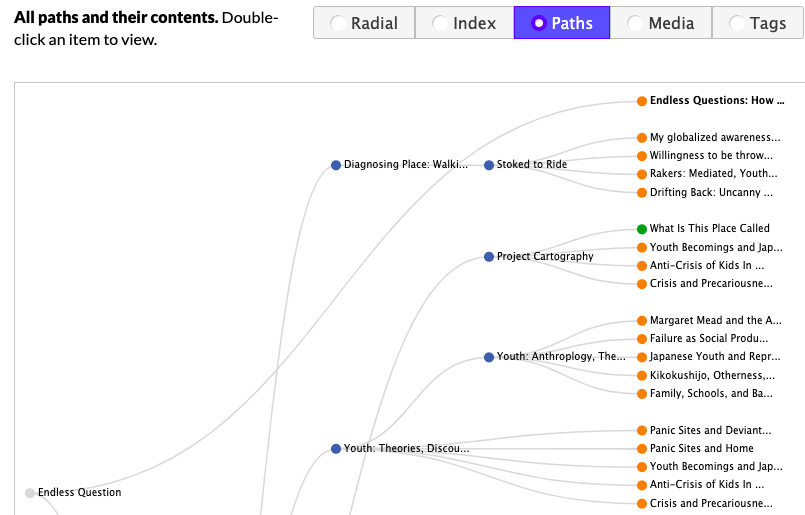Thinking about an #Alt_Diss
This is the beginning of my thinking out loud about using an #AltDiss format for my submission of the dissertation document. I am cognizant of the requirements of the university in terms of the dissertation document [Lakehead University requirements] which include:
- A detailed table of contents
- A brief abstract which provides a concise summary of the dissertation (350 words or less)
- An introduction that clearly states the rationale and objectives of the research
- A comprehensive review of the literature
- The methods, results and discussion
- A final conclusion and summary
- A thorough bibliography or reference list
- Appendices, Tables and Figures (if not included previously)
- An appendix containing an approval of the Research Ethics Board in the case of research involving human subjects or the Animal Care Committee in the case of research involving animal subjects or biohazards.
The format description includes specifications on page size parameters “The dissertation must be typed using a word processor such that if printed it would be on standard letter size paper (8.5 x 11″). A conventional font (11-point or 12-point) must be used. Line spacing must be double or 1.5. All margins should be 2.54 cm (1 inch).” with additional stipulation that the “final dissertation in an electronic format must be submitted to the Faculty of Graduate Studies. The electronic format must be a locked pdf so that no revisions can be made to the thesis once submitted in its final format.“. With this in mind, why should I consider doing this dissertation differently?
The more I read and think about my field of study, my dissertation question, and the constraints of binding the dissertation into a PDF format, the more I know I need to justify why an alternative dissertation format makes sense.
Here are some preliminary links and thoughts, in no particular order.
Naomi Salmon’s dissertation proposal – completed in a Pressbooks format. Since this is one of the tools I’m investigating, this is a model of an AltDiss which also links to a variety of other models of AltDiss publications in a variety of formats and fields of study.

Why use Scalar: http://scalar.usc.edu/students/endlessquestion/index
From Dwayne Dixon’s dissertation: “I have used Scalar as the form to enliven the content and in turn, waken the techno-circuits of information to the play of reading across, down, into, and backwards. Using Scalar as the form for this project is an invitation to create the conditions for a vision and then to reassemble the components and fragments into new configurations. It offers a polyvalent tool for making new connections and relations bright before they fade in another series of encounters with the different pages, paths, tags, and annotations where the stories await to unfold in multiple directions.”

What fascinates me about using Scalar is the interlinking between text, media, and fluid formats such as paths, radials, and tags.
This is the beginning of a justification for doing this differently, in an #AltDiss format.
- Parker Palmer (1987) states “every way of knowing contains its own moral trajectory” (Guba & Lincoln, 2005, p. 209)
- locate myself squarely and deliberately within the text (Guba & Lincoln, 2005 quoting Geertz, 1998)
- voice is multilayered, letting research participants to speak for themselves in text, video, audio, or performative formats
- reflexivity of self, fluidly within the text; as researcher, ‘brought self’, and situationally created self; binaries, contradictions and paradoxes need to be interrogated (Guba & Lincoln, 2005)
- address the crisis of representation, of privileging text (above other communicative devices or mediums (McLuhan’s notion of ‘medium is the message’); “forgo closed, bounded worlds for those more open-ended and less conveniently encompassed” (Guba & Lincoln, 2005, p. 211)
- my thought: how will the #AltDiss allow me to be true to my voice, others’ voices to be embodied in the medium(s) selected to share reflections and narratives (e.g. sketchnote graphics, concept maps, audio podcast, vlog)
- will my choice and justification of my decision for an #AltDiss format impact the trustworthiness of my research? e.g. credibility, transferability, dependability, confirmability (Guba & Lincoln, 2005)
This connects to Guba and Lincoln’s (2005) description of validity as crystalline, when they reference Richardson’s statement “changing one’s relationship to one’s work how one knows and tells”. The metaphor of crystal suggests less triangulation and more reflections and refractions – transmutations, multidimensionality, angles of approach – within primatic colours, patterns & arrays (Guba & Lincoln, 2005). All this calls to mind my fascination with
References
Guba, E. G., & Lincoln, Y. S. (2005). Paradigmatic controversies, contradictions, and emerging confluences. In N. K. Denzin & Y. S. Lincoln (Eds.), Sage Handbook of Qualitative Research (3rd ed., pp. 191–215). Thousand Oaks: Sage Publications.
Image Attribution: Photo by Lukasz Szmigiel on Unsplash
